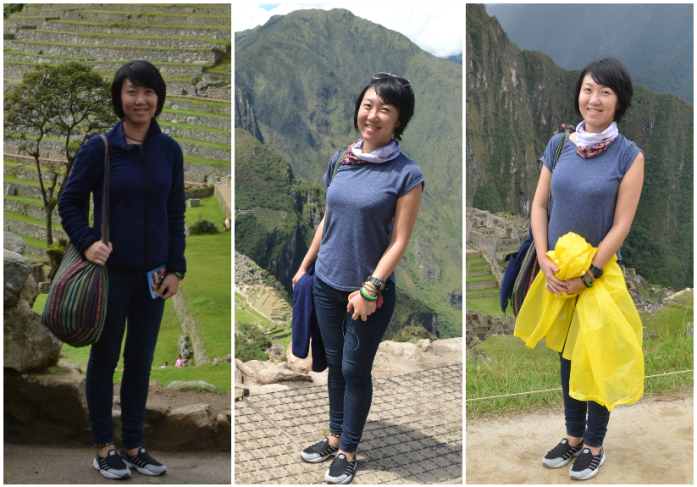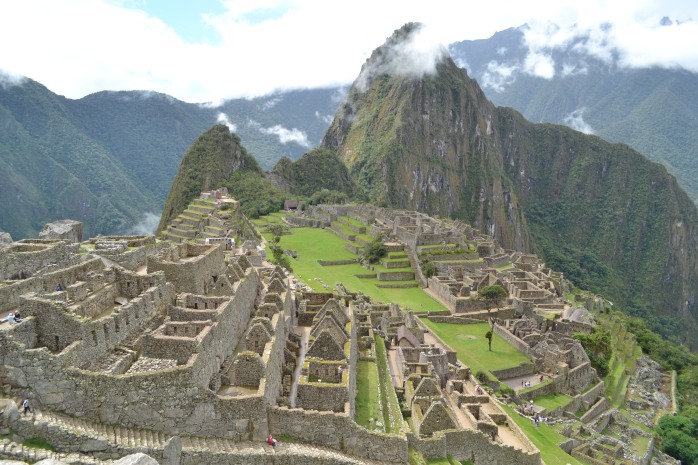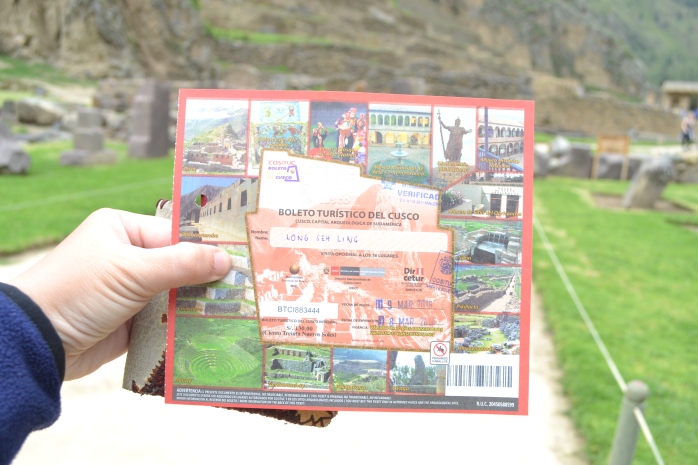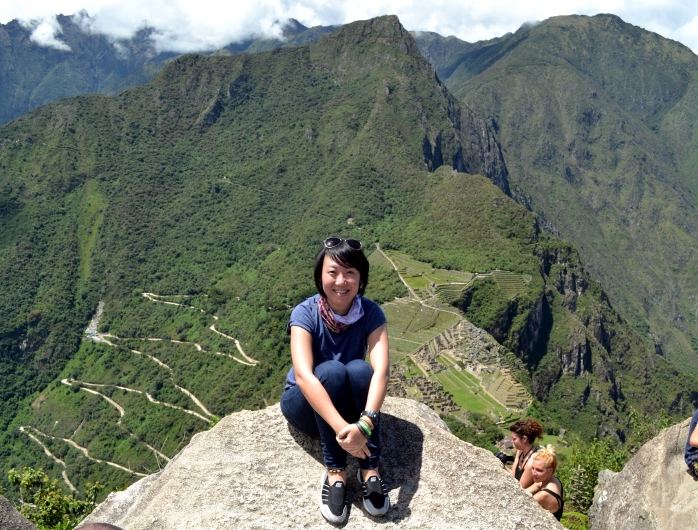After I decided to go for the symposium in Peru, I started to plan for Machu Picchu. The internet is such an amazing place to answer all the questions I had in mind such as how to get there? How many days is enough? How much does it cost? What is the weather like? What and how much should I pack? That was also the time I realised how big Peru is and I probably would not have enough time to go to many places. I do not usually plan too far ahead as I like to have flexible travel plans. However, based on what others shared about their trips, I thought it would be better to plan ahead. Instead of booking for tours, I took the time to plan my trip to Machu Picchu. Blog articles from Escape Traveler, Rich Beattie, Robert Schrader and Jimmy were particularly helpful. I did not want to rush so I allocated 8 days for Machu Picchu and Sacred Valley, which was more than enough and suited my travel pace! And I was not up to hike the Inca Trail, maybe next time!

A map of Machu Picchu and Sacred Valley. Source: http://www.mysteryperu.com/eng/images/map_machupicchu_bytrain.jpg
Day 1: Lima – Cuzco
Day 2: Cuzco
Day 3: Cuzco – Ollantaytambo – Aguas Calientes
Day 4: Machu Picchu + Huayna Picchu
Day 5: Aguas Calientes – Ollantaytambo
Day 6: Ollantaytambo – Cuzco
Day 7: Cuzco
Day 8: Cuzco – Lima
It was relatively easy with all the travel tips. All it took to visit Machu Picchu and Sacred Valley was:
1. Return flight ticket from Lima to Cusco. The ticket can cost between US$150 and US$300 or more, depending on the airlines. I started checking the price 3 months ahead and only bought the tickets 2 months in advance and the price had definitely gone up. Based on the reviews of airlines in Peru, I chose StarPeru as it was cheaper and seemed to be reliable. LAN had the best reviews but was the most expensive. My flight there was delayed but the flight back was on time. Overall, it was good for me. Besides I always ended up sleeping.
2. Collectivo (van) from Cusco to Ollantaytambo. Taking the train from Ollantaytambo is cheaper than from Cusco. From Cusco, the train departs from Poroy Station, which is about 20 minutes drive away. It only costs S.10 to take a collectivo from Cusco to Ollantaytambo whereas it costs more to get a taxi to Poroy Station. The collectivo is quite comfortable and it leaves once it is full. Big backpack or suitcase has to go on the top of the vehicle. I had one backpack which luckily fit on my lap. Along the way, locals started getting off at different stops and there were more seats available. The journey was about one and a half hour and the scenery was really beautiful so try to get a window seat! It would be cheaper to take a collectivo from Cuzco to Urubamba and change another collectivo from Urubamba to Ollantaytamo but most would go for the former to save time.
3. Return train ticket from Ollantaytambo to Aguas Calientes. There are two railway companies that offer the train service from Ollantaytambo, which are PeruRail and Inca Rail. Click here to find out more about the different trains operated by each company. Mark Smith’s write up on train travel in Peru is also informative. I bought the tickets for Expedition Train by PeruRail online as it had the cheapest option. I could only print the tickets at any PerulRail offices at least 4 hours before the departure time. I did mine upon arrival at Cusco Airport. Don’t forget to show the purchase code number, passport and credit card used during online purchase. On the ticket it stated that only 4 kg hand carry was allowed. In my head I thought, that must be absurd! Nonetheless, I left one of my backpack at Cusco and took only one which was definitely still over 4 kg anyway. However, to my surprise, the train was more spacious and luxurious. There was definitely enough space for luggage. There was luggage compartment like any other trains, plus ample space on the floor between the seats. I was lucky enough to get a window seat on both the journey there and back. The windows were big, even at the top of the train, which gave everyone a good view along the ride. The service was tip top, drinks and cookies were served. But then for the price I paid, I should be expecting such a service because when it is converted to Ringgit Malaysia, the train cost almost RM500!
4. Return shuttle bus ticket from Aguas Calientes to Machu Picchu. The ticket can be purchased using US$ or Peruvian Sol at Aguas Calientes. The ticket counter is just next to the bust station. I bought the ticket a day before to avoid the queue early in the morning. Passport is needed during purchase as the name and passport number are printed on the ticket. The shuttle buses run regularly from Aguas Calientes, starting at 5.30am. The ticket did not have any allocated time. I went to the bus station at 5.30am and it was already a long queue but it didn’t take long. It was a winding road up to Machu Picchu and it took approximately 15-20 minutes to arrive the entrance. There were a lot people although it was not even 7am! There was even a long queue at the entrance to get in!
5. Entrance ticket to Machu Picchu and Huayna Picchu. Of all, this was probably the most important ticket to secure. There is a limitation on the number people entering per day. There are different categories of daily tickets:
Machu Picchu (S.128) – 2,500 visitors
Machu Picchu + Huayna Picchu (S. 152) – 200 visitors for each time slot at 7-8 am or 10-11 am
Machu Picchu + Mountain (S. 142) – 800 visitors divided into two time slots at 7-8 am or 9-10 am
Machu Picchu Horario Vespertino 13:00 Horas (S. 90) – 1000 visitors to enter after 1 pm
There are two websites to buy the ticket online, the government official website and a travel agency and tour operator. I read about problems paying for the ticket with their credit cards through the official website. However, to book through the agent website was a total rip off! For example, it only cost S. 128 (approximately US$40) for the entrance ticket and the agent is selling at US$62! Thanks to Andy’s step-by-step instructions on how to book the tickets online, it was really simple and luckily my credit card transaction was successful!
6. Cusco Tourist Ticket / Boleto Turistíco del Cusco. Most of the places to visit in Sacred Valley require entrance tickets. This ticket is a collective ticket allowing entrance to 16 places, including Pisac, Ollantaytambo, Chinchero, Moray, Tambomachay, Pukapukara, Qénqo, Sacsayhuaman, Pikillacta, Tipón, Pachacutec Monument, Museum of Contemporary Art, Popular Art Museum, Regional Historical Museum, Archaeological Museum of the Qoricancha, and Performance of Andean Dances and Live Music. The ticket can be purchased at most of the entrances and is valid for 10 days. The ticket is stamped upon each entry, allowing single entry to each place. For other ticket options, click here.
7. Cusco Half Day Tour 2-6pm. Most places on the Cusco Tourist Ticket are not within walking distance from each other. It is easier and cheaper for solo traveller like me to join a tour, which I booked just a day ahead. They quoted me US$25 and I was shocked as I could book the same tour online at US$10! In the end I paid US$10. The half day tour included an English-speaking guide and visit to Plaza de Armes, Cathedral of Santo Domingo, Qoricancha, Sacsayhuaman, Qénqo, Tambomachay and Pukapukara. There was additional entrance fee for the Cathedral and Qoricancha as the Cusco Tourist Ticket did not include those. It was a nice tour and very informative. I did not have a guide throughout the whole trip so it was really good to hear the history of the Sacred Valley and the Inca Empire.
8. Hot Spring at Aguas Calientes. It is an open air hot spring, a bit crowded and maybe not so clean but it was quite fun. It costs only S. 10. I read about it and actually brought my bikini to Peru, except that I left it in Cusco. Luckily there were a few shops that sell and rent swimsuits and towels. It was only S. 3 to rent a swimsuit.
9. Accommodation. This is one of the final things to book. The initial plan was to head straight to Ollantaytambo and spend 2 nights there to avoid altitude sickness as Ollantaytambo is situated at a lower elevation than Cusco. I only booked 2 nights at Ollantaytambo and 2 nights Aguas Calientes through AirBnb as I did not want to spend time looking for a place upon arrival. I planned to only look for hostels on my last few nights after I arrive at Cusco. It was a coincidence that my Dad found out about a Peruvian AFSer who was in Malaysia 10 years ago and he actually lives in Cuzco so I ended up staying at his place. Instead of going to Ollantaytambo straight away, my plan changed.
I was there during summer but the weather was unpredictable. It could change from foggy and cold to sunny and burning hot to rainy and wet in one day. During the day it could get really hot but as the sun disappeared the temperature dropped. Best to wear layers like a t-shirt and fleece jacket. Denim jeans was fine with me, it did not get too hot although I saw many who changed into shorts when the sun came out. Peru is probably one of the country with the highest UV so do apply lots of sunblock frequently and make sure it is high SPF sunblock, at least above 50! Sunglasses is a must! A hat would be good, especially one with neck and ears cover. Of course a good pair of hiking shoes and best if they are waterproof! A raincoat or umbrella, even though I had both! A large bottle of water and some snacks. Most importantly, never ever forget the passport, tickets and credit cards used to purchase the tickets.

Usually colder early morning, then it started to get hot and hotter and the fleece jacket came off. The raincoat or umbrella came out every time it rained.
For many, 8 days is a lot but for me it was not enough because I spent a lot of time hanging out with local friends, instead of doing sightseeing. No regrets though! If I had more days, I would definitely visit Pisaq, Chinchero, Moray, Pikillacta and Tipón. So how much in total did I spend? Here is the breakdown:
| Return flight from Lima to Cusco | US$ 208.45 | RM 899.41 |
| Return collectivo from Cusco to Ollantaytambo | S. 20.00 | RM 24.92 |
| Return train ticket from Ollantaytambo to Aguas Calientes | US$ 111.00 | RM 476.52 |
| Return shuttle bus from Aguas Calientes to Machu Picchu | US$ 24.00 | RM 109.66 |
| Entrance Ticket Machu Picchu + Huayna Picchu | S. 158.13 | RM 191.86 |
| Cusco Tourist Ticket | S. 130.00 | RM 162.00 |
| Cusco Half Day Tour | US$ 10.00 | RM 42.95 |
| Barraco Andino Church, Cusco | S. 10.00 | RM 12.46 |
| Cathedral of Santo Domingo, Cusco | S. 25.00 | RM 31.15 |
| Qoricancha, Cusco | S. 10.00 | RM 12.46 |
| Hot Spring, Aguas Calientes | S. 13.00 | RM 16.20 |
| 4 Nights Accommodation | RM 252.00 | |
| Food | S. 116.00 | RM 144.55 |
| Taxi | S. 32.00 | RM 49.84 |
| Toilet | S. 4.00 | RM 4.98 |
| TOTAL | ≈ US$600.00 | RM2430.96 |
It was not cheap at all. Besides, Malaysian currency was so low when I travelled. The exchange rate for US$ was between 4.0-4.3. I could not buy Peruvian Soles in Malaysia so I brought US$ to change in Peru. Even if I had hiked on the 4-day Inca Trail, it would have cost me US$390 and plus the flight, it would be near US$600, not including any days in Sacred Valley. However, a friend of mine had managed a day trip to Machu Picchu from Cusco, which could be the cheapest option to see Machu Picchu without exploring Sacred Valley.
Nonetheless, Machu Picchu is such a spectacular place that it is definitely worth a visit, or even a second visit, but it is getting more expensive every year. I was also lucky enough to have an AFSer hosting me in Cusco, plus I also tried Couchsurfing for the first time in Lima. Staying with locals did not only save on accommodation, it was also a good way to to explore Peru and know more about the local places, culture and food. It has been a long time since I travel on my own but I truly enjoyed the freedom and flexibility, as well as meeting different travellers and locals.




Nice ! Thank you for sharing the info.
You’re welcome Muiz!! Hope to catch up with you one day!